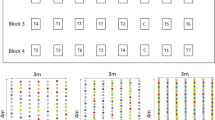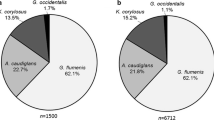Abstract
The interactions of major pests with their natural enemies in the environment of intercropped orchards have recently received much attention. In this study, eight aromatic plant species, namely Mentha canadensis L. (Lamiaceae), Tagetes patula L. (Asteraceae), Ocimum basilicum L. (Lamiaceae), Satureja hortensis L. (Lamiaceae), Agerarum houstonianum Mill (Asteraceae), Ocimum × citriodorum Vis. (Lamiaceae), Nepeta cataria L. (Lamiaceae) and Centaurea cyanus L. (Asteraceae), were used to evaluate the effects of intercropping with aromatic plants on Comstock mealybugs (Pseudococcus comstocki Kuwana) and their natural predators. The effects of meteorological factors on Comstock mealybug were also investigated. Compared with natural grass or clean tillage plots, intercropping with aromatic plants significantly reduced the abundance of Comstock mealybugs and increased that of their predators, thereby increasing the ratio of natural enemies to pests. In the intercropped plots, the individual number Comstock mealybugs was reduced by 22.71–76.76 %; the peak period for Comstock mealybugs was delayed by 10–20 days, and the peak period for their predators was advanced by 0–60 days. The presence of Comstock mealybugs was significantly positively correlated with precipitation in all plots and significantly negatively correlated with sunshine duration. In conclusion, intercropping with aromatic plants significantly reduced the individual number of Comstock mealybugs, especially intercropping with A. houstonianum. Furthermore, this effect was enhanced during the summer months with high precipitation levels and long periods of sunshine.


Similar content being viewed by others
References
Agnello AM, Spangler SM, Reissig WH, Lawson DS, Weires RW (1992) Seasonal development and management strategies for Comstock mealybug (Homoptera: Pseudococcidae) in New York Pear Orchards. J Econ Entomol 85:212–225
Andrew NR, Hughes L (2005) Arthropod community structure along a latitudinal gradient: implications for future impacts of climate change. Aust Ecol 30:281–297
Awmack CS, Leather SR (2002) Host plant quality and fecundity in herbivorous insects. Annu Rev Entomol 47:817–844
Bale JS, Masters GJ, Hodkinson ID, Awmack C, Bezemer TM, Brown VK, Butterfield J, Buse A, Coulson JC, Farrar J (2002) Herbivory in global climate change research: direct effects of rising temperature on insect herbivores. Global Change Biol 8:1–16
Basedow T, Hua L, Aggarwal N (2006) The infestation of Vicia faba L. (Fabaceae) by Aphis fabae (Scop.) (Homoptera:Aphididae) under the influence of Lamiaceae (Ocimum basilicum L. and Satureja hortensis L.). J Pest Sci 79:149–154
Belay D, Schulthess F, Omwega C (2009) The profitability of maize–haricot bean intercropping techniques to control maize stem borers under low pest densities in Ethiopia. Phytoparasitica 37:43–50
Cai WZ, Pang XF, Hua BZ, Liang HW, Song DL (2001) General Entomology. China Agriculture University Press, Beijing (in Chinese)
Catherine R (1997) The potential of botanical essential oils for insect pest control. Integr Pest Manag Rev 2:25–34
Charles JG (1993) A survey of mealybugs and their natural enemies in horticultural crops in North Island, New Zealand, with implications for biological control. Biocontrol Sci Technol 3:405–418
Chogo JB, Crank G (1981) Chemical composition and biological activity of the Tanzanian plant Ocimum suave. J Nat Prod 44:308–311
Finch S, Billiald H, Collier RH (2003) Companion planting-do aromatic plants disrupt host-plant finding by the cabbage root fly and the onion fly more effectively than non-aromatic plants? Entomol Exp Appl 109:183–195
Fitzgerald JD, Solomon MG (2004) Can flowering plants enhance numbers of beneficial arthropods in UK apple and pear orchards? Biocontrol Sci Techn 14:291–300
Friberg M, Wiklund C (2010) Host-plant-induced larval decision-making in a habitat/host-plant generalist butterfly. Ecology 91:15–21
Gravesen E (2008) Linyphiid spider populations in sustainable wheat-clover bi-cropping compared to conventional wheat-growing practice. J Appl Entomol 132:545–556
Guerrieri E, Pellizzari G (2009) Parasitoids of Pseudococcus comstocki in Italy Clausenia purpurea and Chrysoplatycerus splendens: first records from Europe. Bull Insectol 62:179–182
Helenius J (1990) Incidence of specialist natural enemies of Rhopalosiphum padi (L.) (Horn., Aphididae) on oats in monocrops and mixed intercrops with faba bean. J Appl Entomol 109:136–143
Hendry AP (2005) Evolutionary biology: the power of natural selection. Nature 433:694–695
Jembere B, Obeng-Ofori D, Hassanali A, Nyamasyo G (1995) Products derived from the leaves of Ocimum kilimandscharicum (Labiatae) as post-harvest grain protectants against the infestation of three major stored product insect pests. Bull Entomol Res 85:361–367
Jones GA, Gillett JL (2005) Intercropping with sunflowers to attract beneficial insects in organic agriculture. Fla Entomol 88:91–96
Kasper ML, Reeson AF, Mackay DA, Austin AD (2008) Environmental factors influencing daily foraging activity of Vespula germanica (Hymenoptera, Vespidae) in Mediterranean Australia. Insect Soc 55:288–295
Khan ZR, Pickett JA, Wadhams LJ, Hassanali A, Midega CA (2006a) Combined control of Striga hermonthica and stemborers by maize–Desmodium spp. intercrops. Crop Prot 25:989–995
Khan ZR, Midega CA, Hassanali A, Pickett JA, Wadhams LJ, Wanjoya A (2006b) Management of witchweed, Striga hermonthica, and stemborers in sorghum, Sorghum bicolor, through intercropping with greenleaf desmodium, Desmodium intortum. Int J Pest Manag 52:297–302
Khan ZR, Pickett JA, Hassanali A, Hooper AM, Midega C (2008) Desmodium species and associated biochemical traits for controlling Striga species: present and future prospects. Weed Res 48:302–306
Kim S, Roh J, Kim D, Lee H, Ahn Y (2003) Insecticidal activities of aromatic plant extracts and essential oils against Sitophilus oryzae and Callosobruchus chinensis. J Stored Prod Res 39:293–303
Klapwijk MJ, Grobler BC, Ward K, Wheeler D, Lewis OT (2010) Influence of experimental warming and shading on host-parasitoid synchrony. Global Change Biol 16:102–112
Kong C, Hu F, Xu X, Zhang M, Liang W (2005) Volatile allelochemicals in the Ageratum conyzoides intercropped citrus orchard and their effects on mites Amblyseius newsami and Panonychus citri. J Chem Ecol 31:2193–2203
Lavandero B, Muñoz C, Barros W (2006) The achilles’ heel of biological control: a new vision for your success. Agro-Ciencia 22:111–123
Lensing JR, Wise DH (2007) Impact of changes in rainfall amounts predicted by climate-change models on decomposition in a deciduous forest. Appl Soil Ecol 35:523–534
Logan JD, Wolesensky W, Joern A (2006) Temperature-dependent phenology and predation in arthropod systems. Ecol Model 196:471–482
Nichols JD, Ofori DA, Wagner MR, Bosu P, Cobbinah JR (1999) Survival, growth and gall formation by Phytolyma lata on Milicia excelsa established in mixed-species tropical plantations in Ghana. Agric For Entomol 1:137–141
Pellizzari G, Duso C, Rainato A, Visigalli T (2007) Pseudococcus comstocki (Kuwana) (Hemiptera Pseudococcidae) pest of peach in north-eastern Italy. In: Proceedings of the XI international symposium on scale insect studies (ISSIS XI)
Ponti L, Altieri MA, Gutierrez AP (2007) Effects of crop diversification levels and fertilization regimes on abundance of Brevicoryne brassicae (L.) and its parasitization by Diaeretiella rapae (M’Intosh) in broccoli. Agric For Entomol 9:209–214
Progar RA, Schowalter TD (2002) Canopy arthropod assemblages along a precipitation and latitudinal gradient among Douglas-fir Pseudotsuga menziesii forests in the Pacific Northwest of the United States. Ecography 25:129–138
Root RB (1973) Organization of a plant-arthropod association in simple and diverse habitats: the fauna of collards (Brassica oleracea). Ecol Monogr 43:95–124
Rosenzweig C, Iglesias A, Yang XB, Epstein PR, Chivian E (2001) Climate change and extreme weather events. Implications for food production, plant diseases, and pests. Global Change Hum Health 2(2):90–104
Russell EP (1989) Enemies hypothesis: a review of the effect of vegetational diversity on predatory insects and parasitoids. Environ Entomol 18:590–599
Schader C, Zaller JG, Köpke U (2005) Cotton-basil intercropping: effects on pests, yields and economical parameters in an organic field in Fayoum, Egypt. Biol Agric Hortic 23:59–72
Sekamatte BM, Ogenga-Latigo M, Russell-Smith A (2003) Effects of maize–legume intercrops on termite damage to maize, activity of predatory ants and maize yields in Uganda. Crop Prot 22:87–93
Shelton AM, Badenes-Perez FR (2006) Concepts and applications of trap cropping in pest management. Annu Rev Entomol 51:285–308
Song BZ, Wang MC, Kong Y, Yao YC, Wu HY, Hu JH, Qi LP, Bi NN (2010a) The structure characteristics of arthropod community in plots of pear orchard intercropped with different aromatic plants. Sci Agric Sin 43:763–779
Song BZ, Wu HY, Kong Y, Zhang J, Du YL, Hu JH, Yao YC (2010b) Effects of intercropping with aromatic plants on the diversity and structure of an arthropod community in a pear orchard. Biocontrol 55:741–751
Song B, Zhang J, Hu J, Wu H, Kong Y, Yao Y (2011) Temporal dynamics of the arthropod community in pear orchards intercropped with aromatic plants. Pest Manag Sci 67:1107–1114
Sutherst RW (2000) Climate change and invasive species-a conceptual framework. In: Mooney HA, Hobbs RJ (eds) Invasive species in a changing world. Island Press, Washington, DC, pp 211–240
Tang Q, Feng M (2007) DPS data processing system: experimental design, statistical analysis and data mining. Science Press, Beijing (in Chinese)
Tang GB, Song BZ, Zhao LL, Sang XS, Wan HH, Zhang J, Yao YC (2013) Repellent and attractive effects of herbs on insects in pear orchards intercropped with aromatic plants. Agrofor Syst. 87:273–285
Tylianakis JM, Didham RK, Wratten SD (2004) Improved fitness of aphid parasitoids receiving resource subsidies. Ecology 85:658–666
Uvah III, Coaker TH (1984) Effect of mixed cropping on some insect pests of carrots and onions. Entomol Exp Appl 36:159–167
Walther G, Post E, Convey P, Menzel A, Parmesan C, Beebee TJ, Fromentin J, Hoegh-Guldberg O, Bairlein F (2002) Ecological responses to recent climate change. Nature 416:389–395
Watt AD, McFarlane AM (2002) Will climate change have a different impact on different trophic levels? Phenological development of winter moth Operophtera brumata and its host plants. Ecol Entomol 27:254–256
Yamamura K, Yokozawa M, Nishimori M, Ueda Y, Yokosuka T (2006) How to analyze long-term insect population dynamics under climate change: 50-year data of three insect pests in paddy fields. Popul Ecol 48:31–48
Yuan F, Zhang YL, Feng JN, Hua BZ (1996) Entomogical classification. China Agriculture University Press, Beijing (in Chinese)
Zheng LY, Gui H (1999) Insect classification. Nanjing Normal University Press, Nanjing (in Chinese)
Acknowledgments
Financial support was provided by a National Natural Science Foundation of China project (31171922/31301736) and a scientific research quality improvement project from Beijing University of Agriculture (GJB2013004). The authors thank the Key Laboratory of Pomology at Beijing University of Agriculture and all of the technicians of the Daxing Forestry Administration in Beijing. We also thank Dr. Du Yanli, Beijing University of Agriculture, for her assistance with species identification.
Author information
Authors and Affiliations
Corresponding author
Additional information
Hui Hua Wan and Bei Zhou Song have contributed equally to the work.
Rights and permissions
About this article
Cite this article
Wan, H.H., Song, B.Z., Tang, G.B. et al. What are the effects of aromatic plants and meteorological factors on Pseudococcus comstocki and its predators in pear orchards?. Agroforest Syst 89, 537–547 (2015). https://doi.org/10.1007/s10457-015-9789-7
Received:
Accepted:
Published:
Issue Date:
DOI: https://doi.org/10.1007/s10457-015-9789-7




